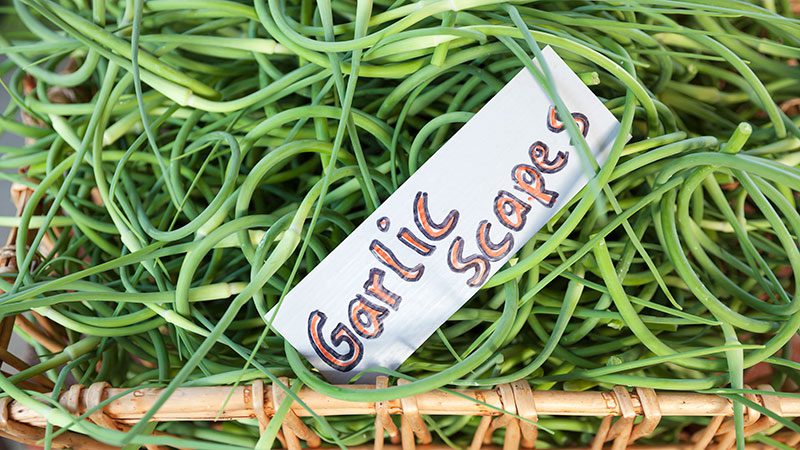Garlic scapes are spring’s best-kept secret

Garlic scapes aren’t as well known as asparagus, but they’re another local-seasonal spring treasure in the Northwest.
One of just a handful of Northwest crops with such a narrow harvest window, scapes signify the time of year as reliably as a woodland trillium.
What are garlic scapes?
Scapes — the tender, mild curlicues that shoot up from the central stalk of hardneck garlic plants in late spring — are clipped by many growers so that the garlic plant can redirect its energy to its bulb. Scapes were once a little-known treat restricted to home gardens and farmers markets — if they weren’t simply discarded.
Scapes have grown a wider audience of fans in recent years, including PCC shoppers. The co-op has stocked the bendy, bright green, curly-topped shoots for more than a decade, said produce merchandiser Elliott Lamoureux. Limited supplies make them “something of a moving target” where all stores may not have them at the same time.
“They’re super versatile — perfect for adding a mild garlic flavor to all kinds of dishes. I especially like them grilled and added to a burger,” he said.
Where are garlic scapes grown
Garlic scapes are grown where garlic is grown! California is by far the nation’s leading garlic producer, with about 27,671 acres harvested, according to 2022 figures, the latest available from the U.S. Department of Agriculture’s National Agricultural Statistics Service (USDA/NASS). That represents more than 80% of garlic production in the U.S. It’s followed far behind by Oregon (with 2,338 acres harvested), then Washington state with 1,321 acres, according to NASS.
Scapes are such a small part of the garlic market that their production isn’t tracked. NASS also does not separate statistics for hardneck vs. softneck garlic, a spokeswoman said. Hardneck garlic, which produces scapes, typically has larger cloves and a stronger flavor, thriving in cooler climates. Softneck garlic typically is milder, with smaller cloves in a papery skin, a longer shelf life, and a broader growing zone.
Last year, garlic scapes (plus immature green garlic shoots) were grown in Oregon for Portland-based Organically Grown Company, a PCC supplier. Leek scapes — passingly similar to garlic scapes but thicker, straight, and grown from leeks — are grown by Ralph’s Greenhouse in Skagit County, as well as Oregon suppliers, OGC said.
how to cook garlic scapes
Scapes are entirely edible, including the pointy bulb on the end that resembles a party hat. As with asparagus, thicker stems may be more fibrous.
The Joy of Cooking, the traditional cooking encyclopedia, notes that scapes are also known as “garlic whistles.” It recommends cutting them into 4-inch pieces and pickling them.
Pickling is great to preserve the scapes past their season (canning expert Marisa McClellan has a pickled garlic scape recipe online here), but scapes also fit into a wide variety of simple spring meals.
- They can be grilled, or sauteed in oil, sprinkled with salt and eaten whole.
- It’s easy to sauté gently pungent scapes in a stir-fry in place of leeks or shallots, or to include sauteed scapes in frittatas or scrambles.
- Substitute scapes for all or part of the basil in homemade pesto, or mix sauteed scapes into veggie pasta dishes.
- Sauteed or grilled scapes are also a great seasonal topping on DIY home pizzas.
It’s hard to go wrong cooking with garlic scapes — just fit them in over the next few weeks, before they disappear until next spring.
